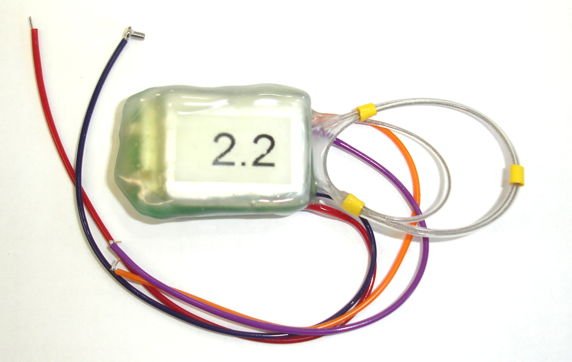
Figure: ISL Stage 5 Deliverables. We have 5 Head Fixtures A3024HFC-B and 5 ISL A3030B. The ISL No2.1 is non-functioning. We see the two-turn command antenna bound up with the one-turn data antenna.
The lamp wires are 100-mm long. The orange lead is L+ and the purple lead is L−. Each pair of lamp wires presents resistance 65 Ω to the flow of lamp current, so that the current through a blue lamp will be close to 35 mA. The EEG leads are 150 mm long. The blue one is X+ and the red one is X−.

Figure: Implantable Sensor with Lamp, A3030B.
In addition to the five ISLs, we are sending five Head Fixtures (A3024HFC-B) with blue LEDs. These are No3.4, 3.5, 5.1, 5.2, and 5.2. They produce 13, 13, 13, 15, and 14 mW blue light respectively at their fiber tips when supplied with 40 mA forward current, as marked on their petri dishes. Our A3030B lamp current is 35 mA, so the light emitted by the fiber tips when connected to the A3030B will be around 12 mW.

Figure: ISL Controller Tool.
Accompanying these circuits, we have the ISL Controller Tool, Version 2.2, which fixes some device-addressing problems present in Version 2.1. Download the script and place it in the LWDAQ Tools/More folder to replace any previous version of the tool you may have installed.
Four of the five A3030Bs are fully-functional: No2.2-2.5. But No2.1 failed after water wash and encapsulation, along with our spare circuit, No2.6. In the future, we have to figure out how to load the battery and wash the solder joints to make the circuit clean, without damaging the lithium-ion battery, which is vulnerable to liquid water, and without causing the circuit, which has power attached, to enter a parasitic state that drains the battery quickly.
Before shipping, we used No2.2 to measure the effect of lamp flashing on the EEG amplifier. We will report on our observations in the next post.
No comments:
Post a Comment